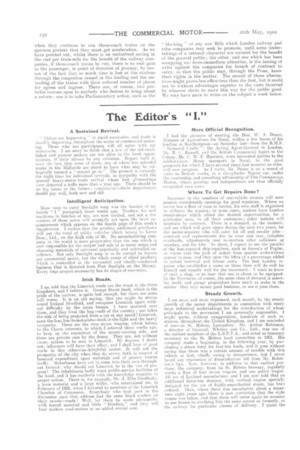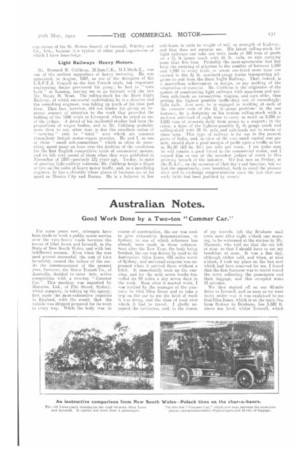The Editor's "I."
Page 2

Page 3

If you've noticed an error in this article please click here to report it so we can fix it.
A Sustained Revival.
1 hinge are happening '' in rapid succession, and trade is ateadily improving, throughout the realm of commercial motoring. Those who are participants will all agree, with my statements:. I am sorry to think that a, few of the old-estale lished and pioneer makers are not alive to the fresh opportunities, if their silence be any criterion. Report hath it. Lime the less, that Anne of them, one of whom has splendid works in the Midlands are about to have what may be colloquially termed a " second go in." The present is certainly the right time for individual revivals, in sympathy with the general heavy-motor trade revival whose first glimmerings were detected a trifle more than a year ago. There should be no big losses in the future ; commercial-vehicle departments should pay well, both new and old.
Intelligent Anticipation.
Mere vans to carry Sunlight soap was the burden of my fourth " 1" paragraph three weeks ago. Tenders, for new machines in batches of ten, are now invited, and not a few readers of these notes will promptly act upon the brief announcement which appears on the fourth page of this week's Supplement. I reckon that the pending additional purchases will put the total of utility vehicles which belong to Lever Bros., Ltd., on the high side of BO. No manufacturing company in the world is more progressive than the one which is now responsible for the output and sale of so many soaps and cleansing materials a universal popularity and unrivalled excellence. Not only Sunlight soap is to be carried to buyers per commercial motor, but the whole range of allied products which is controlled in the successful and ideally-couducted :business that is directed from Port Sunlight on the Mersey. Every huge project necessarily has its stages of execution.
Irish Roads.
I am told that the Limerick roads are the worst in the three kingdoms, and I believe it. George Street itself, which is the pride of the natives, is quite bad enough, but there are some still worse. It is an old saying, that one might be driven round Ireland blindfold, and recognize Limerick again without difficulty by the extra humps. I have motored over them, and they rival the bog-roads of the country ; one takes the risk of being projected from a car at any speed !Limerick, none the less, has its Motorists—both in the light and the heavy categories. There are the nine steam wagons' which belong to the Cleeve interests, to which I referred three weeks ago. to keep up the reputation of the money-earning side, and there are private cars by the dozen. They are, not without cause, seldom to be seen in Limerick. By deerees. I doubt not, influences will have their effect, and T shall hear of good roads in this otherwise-delightful centre. It will aid the prosperity of the city when they do arrive, both in respect of lessened expenditure upon materials and of greater tourist traffic. Motorbuses have yet to come into their own throughout. Ireland: why should not Limerick he in the van of progress? The inhabitants badly want public-service facilities of the kind, and it has residents with the knowledge requisite to proper action. There is, for example, Mr. 3. Ellis Goodbody, a keen motorist and a large miller, who entertained me, in February of 1908, when I lectured to members of the. Limerick Chamber of Commerce. Everybody who took part in the discussion upon that address had the same black soadow on their minds—roads! Well, let them be made adequately, with tarred material and little " blinding," and they will 'bear modern mad-motors at no added annual cost.
More Official Recognition.
I had the pleasure of meeting the Hon. W. A. Deane, Minister of Agriculture for Natal, within a few hours of his landiue at, Southampton—on Saturday last—from the R.M.S.
Balmoral Castle " : the Acting Agent-General in London, Mr. R. C. Russell, an-I the. British Commercial Agent to the Colony, Mr. C. W. F. Harrison, were interested parties to the deliberetious. .Alotor transport in Natal, to the good prospects for which I have several times had occasion to refer. will oow progress. As I write, Mr. Deane is on a round of visits to British works, in a six-cylinder Napier car, under the couriership and consulting advisonship of THE COMMERCIAL Mment, whose prestige and independence are thus officially recognized once more.
Where To Get Repairs Done?
Increases in the numbers of one-vehicle owners will soon present. considerable openings for good repairers. Where an owner has a fleet of vans or lorries, his own staff is organized to embrace the repairs ; in some cases, makers have London repair-shops which afford the desired opportunities, for a particular area, to all their customers; other makers will maintain by contract. There is a demand, at. the moment, and one which will grow apace during the next two years, for the meter-repairer who will cater for all and sundry jobs— renewals and replacements due to wear and tear, complete overhauls, adjustments and re-erection after collisions or smashes, and the like. In short, I expect to sec the parallel of the best-reputed ship-repairers, such as Green's of Poplar, to whose care the pick of orders from marine underwriters appear to pass. and that upon the besis of a percentage added to actual material and labour costs. The first London repairer who establishes a name on these lines will do well for himself and equally well for the movement. I want to know of such a shop, et to hear that one is about to be equipped. In the Provinces, of course, the same class of demand is asserting itself, and garage proprietors have much at stake in the matter they may secure good business, or see it pass them.
Steady Growth.
I am mere and more impressed, each month, by the steady growth of the motor departments in connection with many large industrial undertakings for the introduction of whose principals to the movement I am personally responsible. I might quote, without exaggeration, hundreds of such instances, throughout the United Kingdom, and I am reminded of one—in St. Helens, Lancashire. Mr. Arthur Robinson, a. director oi Greenall. Whitley and Co., Ltd., was one of the earliest members of the L.S.P.T.A., and acted as honorary secretary to the St. Helens local committee in 1901. His company made a beginning, in the following year, by purchasing a steam lorry for four-ton loads, and it goes without saying that there was a certain amount of trouble with this vehicle at first, chiefly owing to inexperience, but I never heard mei expression of dissatisfaction fall from Mr. RobinSWI'S lips. Now, however, in addition to that earliest purchase. the company, from its St. Helens brewery, regularly works a fleet, of four steam wagons. and one petrol wagon. All are of Leyland manufacture, and I am now told that an additional three-ton steamer, with vertical engine specially designed for the use of highly-superheated steam, has been ordered. Thus, where there was uncertainty about a departure eight years ago, there is now conviction that. the right course was taken, and that there will never again be occasion to use horses to anything like the same extent as formerly, or the railway for particular classes of delivery. I quote the expirience of the St. Helens branch of Greenall, Whitley .ind Co., Ltd., because it is typical of other good experiences of Which I have keowledge.
Light Railways -Heavy Motors.
Mr. Everard R.. Calthrop, M,I.Mech.E,, was
Imo of the earliest supporters of heavy motoring. He was appointed, in August, 11197, as one of the delegates of the L.S.P.T.A. Council to the first French trials, but important engineering duties prevented his going; he had to " turn back " at London, leaving ma to go forward with the late Mr. Henry H. West. The rolling-stock for the Barsi Light Railway, of which successful undertaking he is a director and the consulting engineer, wire taking up much of his time just then. That fact, however, did not hinder his giviug an immense amount of attention to the work that preceded the holding of the 1898 trials at Liverpool, when he acted as one of the judges. A detail of his incidental studies had been the proportions of wagon bodies, and to Mr. Calthrop probably more than to any other man is due the excellent ratios of oarrying " area to " total " area which are common throughout British motor-wagon practice. He and I. as one of those " small sub-committees " which so often do something, spent many an hour over the drafting of the conditions for the first English competitive trials of commercial motors, nd we felt very proud of them when they were published in November of 1897—precisely 1.2 years ago. To-day, in spite of growing light-railway interests, Mr. Calthrop keeps a finger or two On the pulse of heavy motor traffic, and, as a specifying engineer, he has a clientele whose places of business are as far apart as Mexico City and Burma. He is a believer in low axle-leads in ratio to weight, of rail, or strength of highway, and that does not surprise me. His latest rolling-stock for light railways can take net train loads of 300 tons of goods 011 a 2ft.-gauge track with 35 lb. rails, no axle carrying more than five tons. Probably the most-spectacular feat has been the carrying of pilgrims to the number of between 1,250 and 1,280 in every train, or about one-third more than are carried in the 5 ft. standard-gauge trains transporting pilgrims to and from the Barsi Light Railway. That, indeed, is a marvellous Achievement in design, to say nothing of the adaptation of material. Mr. Calthrop is the originator of the system of constructiug light railways with maximum and uniform axle-loads on locomotives, wagons, and ears alike, thus getting the highest. possible traffic-duty out of exceedinglylight rails. Just now, he is engaged ill working at each of the extreme sods of the 2;i ft.-gauge problem: in the one instauce„ he is designing on hie system rolling-stock with a uniforLt axle-load of eight tens to carry as much as 2,000 to 3,000 tons of minerals daily from mines to a seaport ; in the other, a type of the lightest-possible 2.1, ft.-gauge, track and rolling-stock with 20 M. rails and axle-loads not in excess of three tons. This type of railway is for use in the poorest parts of India, and, in view of the very-small capital cast per mile, should show a goad margin of profit upon a traffic as low as Rs.50 (E3 Os. 8cIT per mile per week. I am quite sure he will remain a good friend to the eornmercial motor. and I regard him as one of the soundest judges of merit in this growine branch of the industry. We last met on Friday, at the R.A.C., on the occasion of that day's sad function, but we had the opportunity, over breakfast, both to recall the pioneer days and to exchange congratulations upon the fact, that our early faith had been justified by events.




















